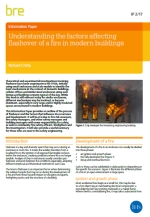Understanding the factors affecting flashover of a fire in modern buildings
BRE (Building Research Establishment) is an independent, research-based consultancy, testing and training organisation, operating in the built environment and associated industries.
On 21 April 2017, BRE published; Understanding the factors affecting flashover of a fire in modern buildings (IP 2/17), written by Richard Chitty.
- The development of a fire in an enclosure can be categorised as:
- Ignition and growth.
- Fully developed.
- Decay and burnout.
The term ‘flashover’ refers to the transition of an enclosure or room fire from a localised fire to the ignition of all exposed flammable surfaces, creating conditions where life is no longer tenable. The time to flashover is important in determining the impact on; escaping occupants, firefighting tactics and the building structure.
Theoretical and experimental investigations involving flashover have been undertaken since the 1950s. Initially they involved small enclosures and scale models, used to identify the basic mechanisms of flashover in the context of domestic buildings, cellular offices and similar-sized enclosures. While this work is still relevant today for similar enclosures, different mechanisms may also be involved, or become dominant, in particular in very large or highly-insulated modern spaces.
This 12-page information paper explains the process of flashover and the factors that influence its occurrence and development. It is intended for fire risk assessors, fire safety managers, other safety managers and building managers with some responsibility for safety, as well as community fire safety officers, firefighters and fire investigators. It will also be useful for those who are new to fire safety engineering.
The contents of the information paper are:
- Introduction.
- Development of a fire.
- Fires in an enclosure.
- Thermal instability.
- Quantifying the conditions for flashover.
- Example calculations for time to flashover.
- Discussion and conclusions.
- References and further reading.
[edit] Related articles on Designing Buildings Wiki
- Automatic fire detection and alarm systems, an introductory guide to components and systems BR 510.
- Automatic fire sprinkler systems: A good practice guide.
- BRE articles on Designing Buildings Wiki.
- BRE Buzz articles on Designing Buildings Wiki.
- Building Research Establishment BRE.
- External fire spread, Supplementary guidance to BR 187 incorporating probabilistic and time-based approaches.
- External fire spread: building separation and boundary distances (BR 187).
- Fire in buildings.
- Fire performance of external thermal insulation for walls of multistorey buildings, third edition (BR 135).
- Fire spread.
- The causes of false fire alarms in buildings.
- The role of codes, standards and approvals in delivering fire safety.
- Visual alarm devices - their effectiveness in warning of fire.
Featured articles and news
RTPI leader to become new CIOB Chief Executive Officer
Dr Victoria Hills MRTPI, FICE to take over after Caroline Gumble’s departure.
Social and affordable housing, a long term plan for delivery
The “Delivering a Decade of Renewal for Social and Affordable Housing” strategy sets out future path.
A change to adoptive architecture
Effects of global weather warming on architectural detailing, material choice and human interaction.
The proposed publicly owned and backed subsidiary of Homes England, to facilitate new homes.
How big is the problem and what can we do to mitigate the effects?
Overheating guidance and tools for building designers
A number of cool guides to help with the heat.
The UK's Modern Industrial Strategy: A 10 year plan
Previous consultation criticism, current key elements and general support with some persisting reservations.
Building Safety Regulator reforms
New roles, new staff and a new fast track service pave the way for a single construction regulator.
Architectural Technologist CPDs and Communications
CIAT CPD… and how you can do it!
Cooling centres and cool spaces
Managing extreme heat in cities by directing the public to places for heat stress relief and water sources.
Winter gardens: A brief history and warm variations
Extending the season with glass in different forms and terms.
Restoring Great Yarmouth's Winter Gardens
Transforming one of the least sustainable constructions imaginable.
Construction Skills Mission Board launch sector drive
Newly formed government and industry collaboration set strategy for recruiting an additional 100,000 construction workers a year.
New Architects Code comes into effect in September 2025
ARB Architects Code of Conduct and Practice available with ongoing consultation regarding guidance.
Welsh Skills Body (Medr) launches ambitious plan
The new skills body brings together funding and regulation of tertiary education and research for the devolved nation.
Paul Gandy FCIOB announced as next CIOB President
Former Tilbury Douglas CEO takes helm.
UK Infrastructure: A 10 Year Strategy. In brief with reactions
With the National Infrastructure and Service Transformation Authority (NISTA).
























